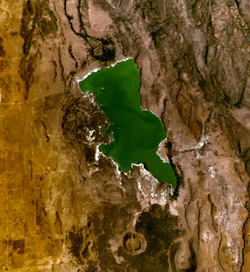Elmenteitan
 | |
| Alternative names | Elmenteitan Culture |
|---|---|
| Geographical range | Kenya, Africa |
| Period | Neolithic |
| Dates | c.3300-1200 BP |
| Type site | Gamble's Cave |
| Major sites | Gamble's Cave, Ngamuriak, Gogo Falls, Njoro River Cave |
| Preceded by | Later Stone Age peoples |
| Followed by | Pastoral Iron Age peoples |
The Elmenteitan culture was a prehistoric lithic industry and pottery tradition with a distinct pattern of land use, hunting and pastoralism that appeared and developed on the western plains of Kenya, East Africa during the Pastoral Neolithic c.3300-1200 BP.[1] It was named by archaeologist Louis Leakey after Lake Elmenteita (also Elementaita),[2] a soda lake located in the Great Rift Valley, about 120 km (75 mi) northwest of Nairobi.
The Elmenteitan was first described by Louis Leakey from excavations at Gamble's Cave (the type site) in 1931 and Njoro River Cave in 1938. Leakey had noticed a locally distinct cluster of the lithic industry and a universal pottery tradition in a restricted area on the plains west of the central Great Rift Valley and at the Mau Escarpment.[3] At Elmenteitan sites, lithic assemblages are distinguished by a high percentage of long symmetrical two-edged obsidian blades which were used unmodified and also served as blanks for a great variety of smaller microlithic tools.[4] Typical Elmenteitan artifact assemblages also include ceramic bowls and shallow stone vessels. Ceramic vessels are mainly undecorated. Several rare, but very distinctive ornamental designs such as irregular punctuation and rim millings have also been found. Occasionally small bowls with out-turned rims, handles with holes or horizontal lugs have been discovered as well.[5]
.jpg)
Domestic cattle and small stock were raised and herded in combination with hunting, fishing and foraging. Patterns and degree of subsistence economy varied greatly depending on location and local and temporal climate.[6][7] Regular cremation of the dead took place in caves (e.g. Egerton Cave, Keringet Caves). Njoro River Cave, first excavated in 1938 by Mary Leakey, served as a mass-burial site. Associated finds include beads, blades, stone bowls, palettes and pottery vessels.[8]
See also
References
- ↑ Lane, Paul J. (2013-07-04). "The Archaeology of Pastoralism and Stock-Keeping in East Africa". doi:10.1093/oxfordhb/9780199569885.001.0001/oxfordhb-9780199569885-e-40.
- ↑ Robertshaw, Peter (1988). "The Elmenteitan: an early food‐producing culture in East Africa". World Archaeology. 20: 57–69.
- ↑ "The Archaeological and Linguistic Reconstruction of African History by Christopher Ehret, Merrick Posnansky". Google Books. Retrieved December 8, 2016.
- ↑ "The Archaeology of Africa: Food, Metals and Towns y Bassey Andah, Alex Okpoko, Thurstan Shaw,". Google Books. Retrieved December 8, 2016.
- ↑ "NOTES ON THE STONE AGE CULTURES OF EAST AFRICA. By L. S. B. LEAKEY,Ph.D., F.S.A." (PDF). Biodiversity Library. Retrieved December 8, 2016.
- ↑ "Elmenteitan". Archaeology Wordsmith. Retrieved December 6, 2016.
- ↑ "A contribution to the study of subsistence patterns of elmenteitan populations with reference to animal bones from Gogo falls in Sourh Nyanza District, Kenya". University of Nairobi Digital Archive. Retrieved December 8, 2016.
- ↑ "Archaeological Sites Njoro River Cave". Act For Libraries. Retrieved December 6, 2016.